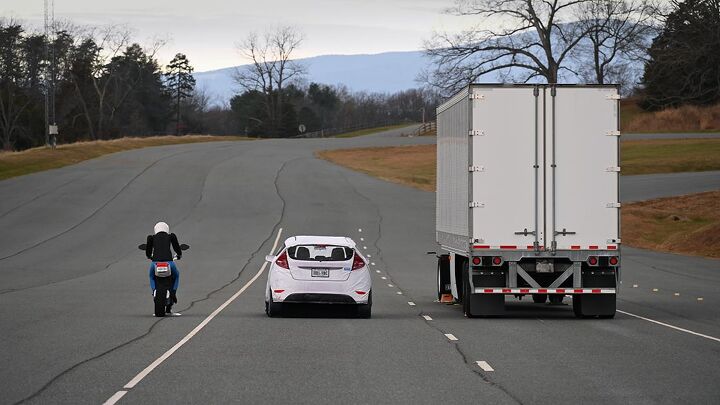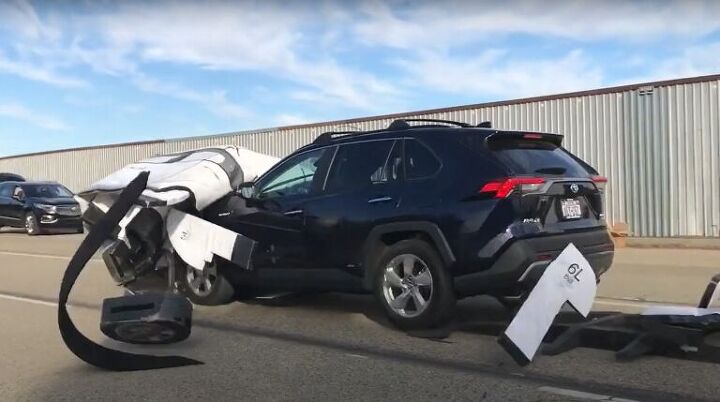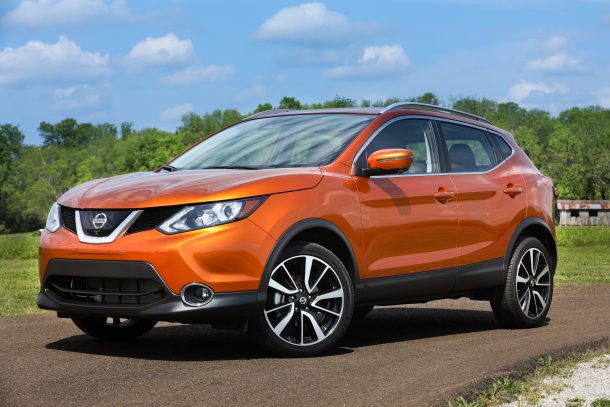#AutomaticEmergencyBraking
Automatic Emergency Braking to Be Required for All New Vehicles in 2029
Automakers are increasingly making advanced driver assist systems (ADAS) like automatic emergency braking (AEB) standard to meet tightening crash-test standards, but that feature will become required by law in 2029. The National Highway Traffic Safety Administration recently finalized a rule requiring that AEB be included on all new vehicles by 2029.
Study: Collision Avoidance Technology Continues to Struggle
New research from the Insurance Institute for Highway Safety (IIHS) is claiming that forward-collision warning and automatic emergency braking are less successful at identifying trucks and motorcycles. In a study that comprised more than 160,000 accidents, the IIHS asserted that these systems prevented accidents with regular passenger vehicles 53 percent of the time. However, motorcycles only benefited 41 percent of the time and trucks 38 percent.
NHTSA Issues Initial Crash Report for Driver Assist Tech
In 2021, the National Highway Traffic Safety Administration (NHTSA) asked manufacturers to begin reporting vehicle accidents where Advanced Driver Assistance Systems (ADAS) and/or semi-autonomous driving aids were engaged. The agency was specifically interested in incidents where such systems were active at least 30 seconds prior to the crash, hoping it might shed some light as to the technologies at play while the industry continues to make it standard equipment.
IIHS Study Suggests Buyers of Used Vehicles Learn Less About Their Car
The Insurance Institute for Highway Safety (IIHS) is claiming that individuals shopping for a secondhand automobile end up learning less about the modern features lurking within their automobiles. Considering salespeople have meetings about how best to hype the advanced driving aids in new models, this one really shouldn’t have required a survey for the IIHS to piece it together. But the outlet appears to be attempting to link this alleged lack of knowledge to make claims that it’ll somehow contribute to the probably of used vehicles being involved in a crash.
“Used car buyers were substantially less likely than new car buyers to know about the advanced driver assistance features present on their vehicles,” stated IIHS Senior Research Scientist Ian Reagan, the author of the study. “They were also less likely to be able to describe how those features work, and they had less trust in them. That could translate into less frequent use, causing crash reductions from these systems to wane.”
Rain or Shine: AAA Finds Out Advanced Driving Aids Still Suck
A new study from the American Automobile Association (AAA) has found that rain can severely impair advanced driver-assistance systems (ADAS). Similar to how highway traffic slows to a crawl when there’s a sudden deluge, modern safety equipment can have real trouble performing when a drizzle becomes a downpour.
On Thursday, the motor club organization released findings from closed-course testing that appeared to indicate some assistance suites had real trouble seeing through bad weather. AAA reported that 33 percent of test vehicles equipped with automatic emergency braking traveling collided with a stopped car when exposed to simulated rainfall at 35 mph. The numbers for automatic lane-keeping was worse, with 69 percent drifting outside the lines. Considering the number of times the people writing for this website have anecdotally criticized ADAS for misbehaving in snow, sleet, rain, fog, or just from an automobile being a little too dirty, it’s hard not to feel a little vindicated.
J.D. Power Reveals What Owners Find Annoying About Automotive Technology
Today’s automobiles are loaded with the kind of technology our grandparents could only dream about. Unfortunately, some dreams aren’t all they’re cracked up to be, and we’ve often bemoaned the many annoyances associated with modern vehicles.
J.D. Power recently shared its Tech Experience Index (TXI) Study, which has been modified to better assess specific features American drivers did and did not enjoy. The general takeaway seems to be that the average motorist feels pretty good about outward-facing cameras and anything else that improves a car’s outward visibility (handy in an era of extra chubby structural pillars).
However, the more intrusive safety inclusions that actively modify how the vehicle responds to the world around it didn’t seem to get nearly as much love, with many respondents suggesting they don’t trust the systems to behave in a predictable manner. It’s something we’re in broad agreement with and echoes many of the complaints we’ve heard from readers, friends, or rattling within our own skulls.
Are Modern Driving Assistance Features Unreliable? AAA Researchers Say Yes
The American Automobile Association (AAA) is recommending automakers limit the use of advanced driving aids after concluding they’re not really up to the challenge of providing reliable safety.
Over the past two years, AAA has focused on testing crash prevention systems to see if they’re all manufacturers claim — deciding that while many are useful in some instances, they’re far too inconsistent to be considered reliable safety nets. Like us, the group worries that making these features commonplace has created a false sense of security among drivers. While one might assume advanced driving aids have to be halfway decent to be put into vehicles, AAA’s pedestrian detection test from 2019 showed they’re anything but consistent.
On Thursday, America’s favorite motor club returned to report on its latest findings on five systems currently offered by the industry. For the test, AAA selected a 2019 BMW X7 with Active Driving Assistant Professional, 2019 Cadillac CT6 with Super Cruise, 2019 Ford Edge with Co-Pilot360, 2020 Kia Telluride with Highway Driving Assist, and a 2020 Subaru Outback with EyeSight. The group was sent to numerous testing sites in California, Utah, and Nevada, and given a 4,000-mile shakedown on public roads — where the outfit found the systems averaged a misstep or disengagement roughly every 8 miles.
Volvo Recalls Every Model Assembled Since the Start of 2019
Volvo is recalling every vehicle sold in the United States from the 2020 and 2019 model year. It turns out the automaker with the reputation for placing extra emphasis on safety has some bunk safety equipment. During tests late last year, the Federation of Danish Motorists noticed the automatic emergency braking (AEB) system in a Volvo XC60 consistently failed to operate as intended — smacking itself into numerous test dummies and automobiles.
After an internal investigation, Volvo Cars issued a global recall encompassing roughly 736,000 units on March 13th. Since the manufacturer has made the feature standard equipment on all vehicles, every single model produced by the automaker since January 21st, 2019 needs to be recalled.
Phantom Braking Leads to Mazda 3 Recall
A system designed to detect obstacles on the road ahead and automatically apply the brakes is acting up in current-generation Mazda 3 vehicles. Seems it’s seeing things that aren’t there.
On Friday, Mazda announced a recall of 35,390 Mazda 3 sedans and hatchbacks in the U.S., spanning the 2019 and 2020 model years.
Reportedly Terrible: AAA Tests Pedestrian Detection Systems
The paranoid luddites that write for this site have occasionally been accused of being hyper critical of modern-day driving aids. Be it a cursory mention of how a little snow totally flummoxed the systems of an otherwise agreeable review car, the direct addressing of an issue where road salt encouraged a vehicle to attempt to steer itself into a ditch, or one of this author’s many diatribes on how the bulk of this technology doesn’t seem anywhere near market ready, there’s always a couple of exceptional individuals ready to call us backward-looking morons.
While that’s often a correct assessment in other matters, it seems we’ve called this one correctly. The American Automobile Association (AAA) recently tested four sedans from competing manufacturers, running them through a handful of scenarios intended to replicate situations that place pedestrians at extreme risk. Taking into account the above smugness, you can probably imagine how poorly it went.
NHTSA Probing Nissan Rogues That Brake for No Reason
Nissan added automatic emergency braking as standard equipment on eight popular models for the 2018 model year, looking to get a jump on the pact forged in 2016 that calls for mandatory AEB on all cars and light trucks by 2020.
That pact, covering 20 automakers, the National Highway Traffic Safety Administration, and the Insurance Institute for Highway Safety, is already bearing fruit. Just last month, the NHTSA congratulated a slew of automakers, including Nissan, for including the safety feature on the majority of their vehicles.
One month later, and the NHTSA finds itself investigating Nissan for a potential fault with its AEB system.
40 Countries Agree - Automatic Braking Should Be Mandatory
Forty countries, led by Japan and the European Union, have agreed to require passenger cars and light commercial vehicles to come equipped with automated braking systems starting as soon as 2020.
According to the United Nations Economic Commission for Europe (UNECE), the new regulation will become compulsory for all countries that adopt it during an upcoming June session. However, the measure will only apply to vehicles operating at “low speeds,” which the U.N. claims is anything under 42 mph.
Cycling Pileup Shows the Unexpected Dangers of Vehicle Safety Aids
Thanks to a pact among the world’s largest automakers, automated emergency braking will soon be standard kit on nearly every new vehicle, paving the way for a future of collision-free bliss. That’s the plan, anyway. While undoubtedly a valuable addition to the automotive landscape, self-thinking vehicle safety systems sometimes reveal their dark side.
That’s what happened Wednesday during the Abu Dhabi Tour — a big-deal cycling race in a locale where hydration no doubt takes on new importance. Fluids weren’t top of mind for five of the cyclists, however, as their race was cut short by a Mercedes-Benz with a mind of its own.
Safety Wars: Nissan to Add Standard Crash-Prevention Feature to Majority of 2018 Models
In the 1950s and 60s it was the horsepower war, followed soon after by the fuel economy battles of the 1970s and 80s. Today, the peace of mind that comes from available safety features competes with horsepower, environmental sensitivity and connectivity to win the hearts and minds of new car buyers.
Owning a vehicle that can head off a crash by itself is a tantalizing prospect for many drivers. With the industry already heading in that direction, Nissan has decided to add automatic emergency braking as standard equipment on eight of its 2018 models.
Consumer Reports Downgrades Tesla Models Over Safety Concerns
Consumer Reports has been pretty hard on Tesla Motors over the past year. The primary point of contention in 2016 was the automaker’s perceived misrepresentation of the company’s Autopilot feature. CR wanted the automaker to disable hands-free operation until its system could be made safer and insisted that it make clear to consumers that it was not capable of true self-driving capability.
While Tesla addressed some of those concerns with its 8.0 software update last autumn, the consumer advocacy publication said it didn’t go nearly far enough — demanding that Tesla stop calling it Autopilot, disable automatic steering, and quit beta testing on its own customers.
Continuing those safety concerns into 2017, Consumer Reports has downgraded both of Tesla’s existing models, claiming the company failed to enable automatic emergency braking features it said would come as standard equipment. This is perplexing, as Model S and Model X vehicles equipped with first-generation Autopilot systems actually had this function.






























Recent Comments